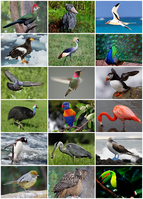
Photo from wikipedia
Cowbirds are a successful group of obligate brood parasites in the Neotropical passerine family Icteridae that offer an interesting model to explore the factors behind the evolution of the bird… Click to show full abstract
Cowbirds are a successful group of obligate brood parasites in the Neotropical passerine family Icteridae that offer an interesting model to explore the factors behind the evolution of the bird craniomandibular complex. The Giant Cowbird, Molothrus oryzivorus, stands out from its congeners, among other features, in diet (feeds mostly on fruit, nectar, and arthropods, instead on seeds), its larger body size, and longer, more robust beak with a much broader bony casque than in other cowbirds. In turn, Giant Cowbirds show a remarkable resemblance in these features to the distantly related caciques and oropendolas (some are its breeding hosts). However, the causes behind the latter resemblance and the distinctiveness among cowbirds have not yet been elucidated. We aim to explore the factors involved in the diverging morphology of the Giant Cowbird from its congeners and the convergence with caciques and oropendolas, surveying their skull and lower jaw under an explicit evolutionary framework. Using geometric morphometrics and comparative methods, we assessed the signal of phylogeny, convergence, feeding ecology, and size in skull shape. Our results indicated that evolution of the craniomandibular complex of icterids in general, and of the beak morphology in the Giant Cowbird in particular, are shaped by multiple factors, with phylogeny being largely overridden by changes in size (evolutionary allometry), primarily, and feeding ecology, secondarily. However, the evolution of a broad bony casque in the Giant Cowbird, otherwise a hallmark of caciques and oropendolas, does not appear to have primarily been ruled by evolutionary allometry. Instead, taking into account the unique extreme convergence between Giant Cowbirds and some of its caciques hosts, it might be consequence of selective regimes associated with parasite–host interactions acting on top of other evolutionary processes. This suggests chick mimicry as a reasonable explanation for this peculiar morphology that would require further investigation.
Journal Title: Journal of Morphology
Year Published: 2021
Link to full text (if available)
Share on Social Media: Sign Up to like & get
recommendations!